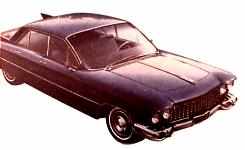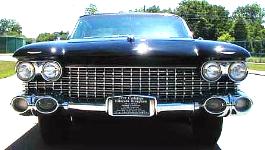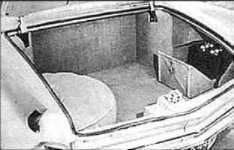[ last update:
04.30.2014
]
The (new)
Cadillac Database©
The Cadillac
Eldorado Brougham
1957 - 1960
Part 10a
Bespoke Broughams
1959
Being a detailed description of the
Cadillac
Eldorado Brougham models of 1959
Return to The (New) Cadillac Database© Index Page
or select preferred chapter
Dramatically and classically beautiful, the Eldorado Brougham presents an
entirely new concept of motor car excellence. Its exclusive design and construction offer
the highest expression of luxurious Fleetwood custom coachcrafting. The poise and bearing
of the Eldorado Brougham ... its elegance and refinement are certain to place it among
man’s most prideful of all material possessions. Here indeed, is a motor car with
distinction, grace and dignity that reflects ... far more powerfully than words ... the
stature of those for whom it was created.
[excerpt from the Cadillac
Data Book for 1959]
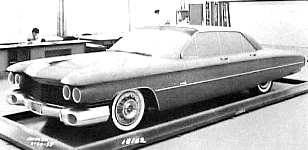
Clay styling model, sans fins, of the future 1959 Eldorado
Brougham;
this shot by Cadillac staff photographer, Madler, is dated Jan. 20, 1958
|
In the Service Information leaflet, the 1959 Brougham was described as a
distinguished member of the Cadillac family, incorporating a custom-built body on a
standard 1959 chassis, and includes every advanced feature for comfort, convenience,
luxury and performance. All equipment that is optional on other 1959 style Cadillac cars,
such as Cruise Control, Air Conditioning, and Air Suspension, is standard on the Brougham.
In exterior and interior appearance, the Brougham has a distinctive style of
its own. A new rear deck, thin roof line and huge compound curve windshield set it aside
from the other models in the range. Driving visibility is vastly improved by
the3-feet-tall windshield that extends far into the roof. Specially tailored tail-fins
accentuate the sculptured body sides.
The classically simple lines of the 1959 Eldorado Brougham
by Fleetwood, and particularly its lower tail fins, emphasize the exclusive character of
this majestic motor car. They were a preview of things to come from Cadillac in 1960. Few
ornaments are used. A small, chrome plaque bearing the words Brougham, by Cadillac
on a blue enamel, cloisonné background, graces the front fenders just ahead of the front
doors, above the chrome side spear.

Striking difference between this and regular 1959
Cadillac models
is the absence of the gigantic fins with their bullet-shaped tail-light pods
|
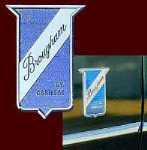 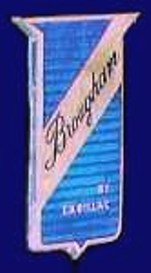 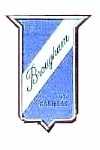
Three views of the Brougham ID plate on the
front fenders,
located above the chrome body spear, just ahead of the front door
|
The 1959 and 1960 Cadillac Broughams are the last of the hand crafted
cars, despite being production models, that is models included in the product catalogs for
these two years. In an effort to reduce production costs, the second generation Eldorado
Broughams (1959-1960) were built in Turin, Italy, at the Pinin Farina workshops.
Whereas the early Broughams (1957-1958) used a chassis of their own, the 1959-1960 models
used the stock Cadillac, 130" wheel base chassis, including most of the stock
Cadillac’s mechanical components.
These included the floor pan, lower body interior panels, seat structures,
instrument panel, dashboard, door pillars, hinges, inner door panels [these were modified
but used stock hardware], lower front bumper, grille blades [but not the bullets, for a
cleaner less cluttered look], headlamp bezels, rear wheel skirts, wheel covers and
modified lower rear bumper. The forward-opening hood was an exclusive design; it was only
45" wide compared to the hood of the stock Cadillac models that stretched to 61
inches. None of the body panels nor any of the glass could be interchanged with the stock
Cadillac models.
Narrow, chromed Cadillac crests dress the leading edge of the front fenders and
the center of the lower edge of the trunk lid. A slim, stylized "Goddess",
reminiscent of the type used on Cadillacs from 1953 through 1956, adorns the front hood.
Equally slim chrome moldings outline all the glass areas. As far as styling goes, this car
is, in my opinion, the Madame X of the post-war Cadillacs.
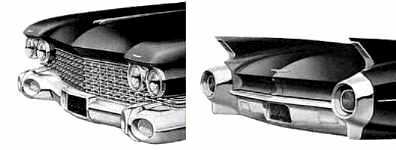

Four different artist's views of front and rear clips
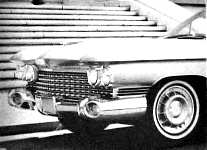 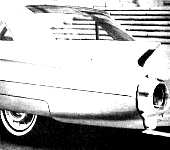
Front and rear clips are atypical of regular 1959
models; a modified front grille
and similar low fins appeared on the regular 1960 and 1961 Cadillac models
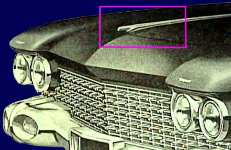 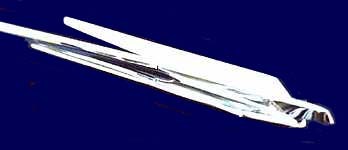
Left: this image appears in the 1959 Cadillac
Data Book
Right: The last Cadillac Goddess, was mounted on the bespoke 1959 Eldorado
Brougham models
this one from ill-fated car #67 of the 99 units built that year
|
The Cadillac chassis and other usable hardware [crated separately] were shipped
to Genoa, Italy (located about 100 miles west of Turin). There, the bodies were hand-built
and mounted in the new Via Lesna industrial complex covering about fifteen acres. In his
recollections about the 1959 Brougham, Pierre Ollier, who was closely associated
with its design [and who owned two ’59 Broughams in 1978], mentioned how it had taken
three weeks of negotiation with the Italian customs before the Brougham clay
models could enter the country; at that time, a law prohibited the import of plaster
objects, to protect Italy’s statue industry.
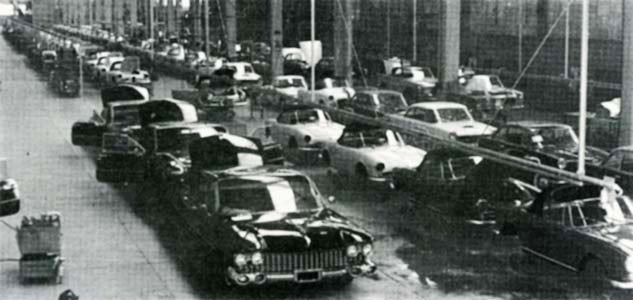
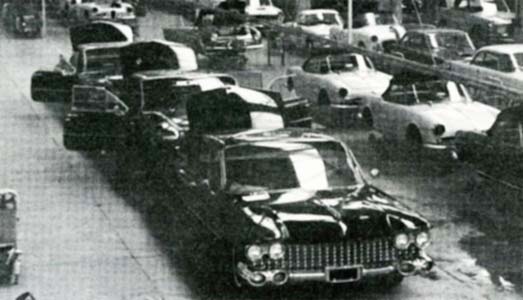
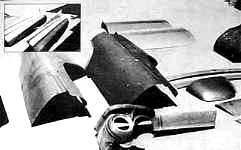
[Top] stationary assembly line at Pinin Farina's plant in Turin; three Broughams nearing
completion [Photo: PF archives]
[Immediately above: preformed body panels were shipped to Turin,
Italy, to be assembled and fitted [Photo: Pierre Ollier collection]
|
The Italian coach builder was commissioned by Cadillac to build
one hundred Brougham bodies a year; Farina had to accommodate them in addition to
other regular work his shop was doing for Alfa Romeo, Ferrari, Fiat and Lancia. The 1959
production totaled only 99 units while those of 1960 numbered 101. An unconfirmed rumor
has it that one of the 1959 chassis was dropped in the harbor at Detroit, during loading
operations for Italy, which may explain why Farina had to build one extra unit for 1960.
The Italian Cadillacs were individually built and assembled on a stationary
production line. Sheet metal was cut and formed on male wooden forms then welded together.
Seams were filled with lead. Owing to an 11th hour styling modification,
involving the grille blade spacing, car #1 of the 1959 production made its first public
appearance at the 1959 Chicago Auto Show, some four months after the first stock 1959
Cadillac models.
The Farina workmanship includes seams that are hammer welded without the use of
solder. Potential rust spots are filled with sealer. Chrome trim is made from brass
castings. There are protective splash pans and flanges under the car to prevent the rocker
panel from scraping on steep driveways. The hood, trunk and doors all fit perfectly and
tolerances along the panel edges do not vary a fraction of an inch. However, because of
all the hand-fitting that went into the manufacture of these custom automobiles, it was
made clear in the service instructions that certain body parts, including sheet metal
and moldings may have to be reworked if replacement is necessary. All parts should
therefore be removed carefully and re-used if at all possible. Any new part must be
matched against the removed part to make certain that it is identical in shape and size
before installation is attempted (!)
That was not the only difficulty. Owing to the stylish but very narrow hood,
and the fact that it was hinged at the front and not at the windshield, some simple
service and maintenance jobs required the prior removal of the complete front bumper and
grille assemblies (e.g. to remove and install the air suspension accumulator tank, which
was a five-minute job on a standard ’59 Cadillac)! Similarly, to remove a tail-light
reflector and socket requires prior removal of the entire rear bumper!
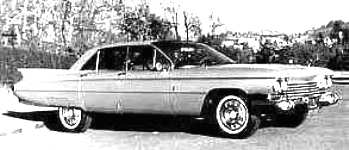 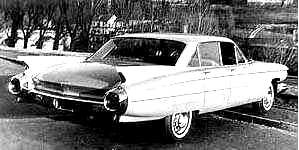
These two photos show the air suspension in fully
inflated mode during tests
[ Photos: PF archives, 1959 ]
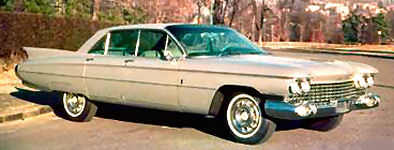
Rare color version of above, LH photo
|
The completed cars were shipped back to Cadillac in Detroit for
final finishing, trials and distribution to selected dealers. The first ones were
available to the public starting in March 1959, whereas regular Cadillac models were
available already in late Fall, 1958.

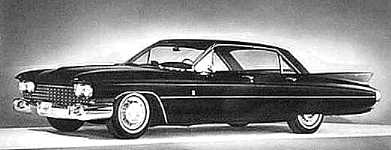
Well-known factory publicity photo

The 1959 Eldorado Brougham at the Chicago
Motor Show, 1959
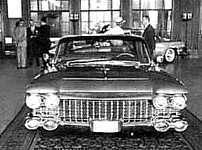
The 1959 Brougham in a showroom
|
In the 1959 Brougham, when either rear door is opened, the quarter
window slides back a couple of inches to allow more room for entry and egress. But, like
the air-suspension system, this new gadget is prone to problems. Six pages are reserved
for it alone in the Service Information booklet - not to mention additional service
information included in monthly Cadillac Serviceman bulletins published after the
’59 Brougham was released.
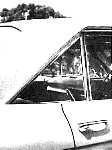
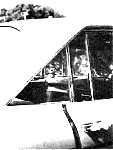
As door catch is released, rear quarter-window
moves back to line up with rear fender
|
The windshield measures a full three feet from hood to roof line, in the
center. This sometimes causes annoying light reflections in the upper corners and while it
keeps front seat passengers legs warm in sunny winter weather, it gently roasts them in
summer, even with full A/C on.

Color illustration from 1960 Cadillac sales catalog...
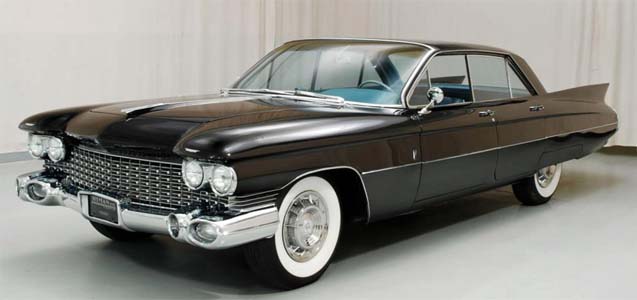
...and a superb survivor
|
The unsightly windshield dog-leg "A" pillar is gone. The 1959 Brougham
prefigures a return to the former, more conventional "A" pillars.
Two interior options are offered: full leather, with broad piping and buttons [image below, right], or a more plain soft fabric trim with a very
narrow piped upper seat back and cushion front [image below, left]. The Florentine-grained
leathers came in white, black, gray, blue, green and sandalwood. The broadcloth upholstery
came in gray [below, left], blue, beige, green and tan covert.
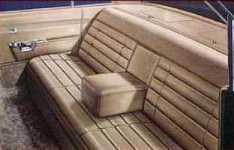 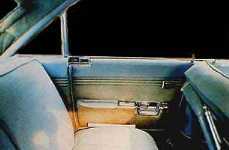
[Left] Leather trim option, [Right] Broadcloth trim
option
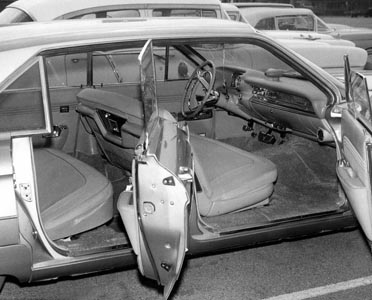
|
There is a complement of small storage compartments and warning lights. The
instrument panel is a stock 1959 model with some additional knobs and controls for the
many accessories.
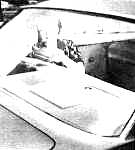 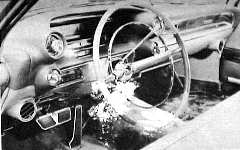 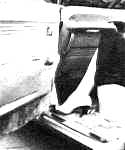
Left: storage compartments on rear shelf;
center: instrument panel; right: rear access and leg room
|
Not available in the 1959-60 Eldorado Brougham models was the former,
complex memory-seat. However, Cruise-Control was introduced by Cadillac this year
and came as standard equipment on the Brougham. In addition an electric clock is
mounted in the back of the front seat, in a highly polished walnut panel.
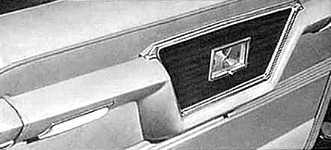
Electric clock on back of rear seat
|
Unlike the early Broughams of 1957-58, the new 1959 models do not
feature a fully power-operated trunk lid; there is only the standard electric trunk lid
release. Although not as roomy as that of standard Cadillac models for 1959 is fully
and plushly carpeted, with matching covers for the spare tire and battery. These are
located at opposite sides of the compartment. From the picture, on the right, there does
not seem to be room for lots of luggage, and particularly not for the bag of golf
clubs so often featured in such publicity shots to demonstrate the roominess of the
Cadillac trunk.
The Brougham engine was the same as that used in the Eldorado
coupe and convertible. It is a triple-carburetor version of the familiar Cadillac V-8,
producing 345 hp at 4800 rpm. Rear axle ratio is 3.21-to-1. Air suspension was again used
in preference to conventional coil springs.
Owing to its superior weight and despite 20 added horsepower and lower gearing,
the Brougham, on testing, did not perform as well a stock Series 62
sedan of the same year. With a 0-to-60 time of 11.7 seconds, it was in fact 1.4 seconds
slower.
On the 1959-60 Brougham models Cadillac used a modified version of the
air suspension system it had introduced in 1957. The latter used an electric air
compressor that worked only when air was needed in the system; the 1959-60 cars have a
belt driven compressor that supplies compressed air all the time the engine is running. A
relief valve prevents too much pressure from building up. Sadly, Cadillac scrapped all NOS
air-suspension parts in 1975, rendering them very hard to find. Current owners of these
models may be interested to know that the leveling valves from post-1965 Fleetwood air
shocks may be modified to fit the 1959-60 Broughams. Late seventies GMC motor homes used
an air compressor similar to the one used in the 1957-58 Brougham models; conversion is
possible. Ride is extremely smooth. The air suspension takes the jolt out of just about
any surface (including railroad crossings) at any speed.
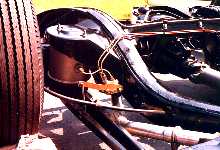 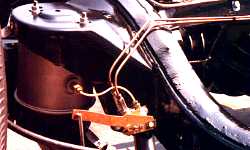
Detail of rear suspension with air dome, leveling
valve and copper tubing
|
Noise level in the Brougham is quite low. Aside from the air-conditioning
blower, the hum of the tires on the pavement is about the loudest thing to be heard.
Trivia
The German Cadillac vendors, Müller & Hensel, offered a '59 Brougham
[#69] for sale in MK, 6/1991 (p.55 - seen in HW coll.). For current news of that car,
check out the "Survivors"
page.
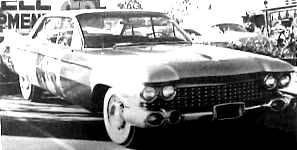
Unidentified survivor, photographed in the sixties
|
Return to The (New)
Cadillac Database© Index Page
or select preferred chapter
© 1996, Yann Saunders and the Cadillac-LaSalle
Club, Inc.
[ Background image: Artist's view of 1959 Eldorado Brougham front and rear
clips ]
